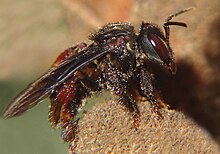Trigona: Difference between revisions
m Bot: Migrating 3 interwiki links, now provided by Wikidata on d:q1938037 |
Added section and link to Vulture bees |
||
| Line 32: | Line 32: | ||
==Range== |
==Range== |
||
'''''Trigona''''' species occur throughout the [[Neotropical]] region, and also throughout the Indo-Australian region; as presently defined, no members of the genus occur in [[Africa]]. |
'''''Trigona''''' species occur throughout the [[Neotropical]] region, and also throughout the Indo-Australian region; as presently defined, no members of the genus occur in [[Africa]]. |
||
==Vulture bees== |
|||
[[Vulture bee|Vulture bees]] comprise of three Trigona species that are the only known bees not to be herbivores. |
|||
==Selected species== |
==Selected species== |
||
Revision as of 06:09, 3 May 2013
| Trigona | |
|---|---|

| |
| Trigona spinipes | |
| Scientific classification | |
| Kingdom: | |
| Phylum: | |
| Class: | |
| Order: | |
| Superfamily: | |
| Family: | |
| Subfamily: | |
| Tribe: | |
| Genus: | Trigona Jurine, 1807
|
| Subgenera | |
|
Duckeola | |
Trigona is the largest genus of stingless bees, formerly including many more subgenera than the present assemblage; many of these former subgenera have been elevated to generic status.[1] There are approximately 150 species presently included in the genus, in 11 subgenera. They differ from those groups now excluded in only minor structural details, primarily of the hind leg.
Range
Trigona species occur throughout the Neotropical region, and also throughout the Indo-Australian region; as presently defined, no members of the genus occur in Africa.
Vulture bees
Vulture bees comprise of three Trigona species that are the only known bees not to be herbivores.
Selected species
- Trigona barrocoloralensis [2]
- Trigona branneri—Mato Grosso (BR) [3]
- Trigona carbonaria—Queensland (AU) [4][5]
- Trigona chanchamayoensis—Mato Grosso (BR) [3]
- Trigona collina Thailand
- Trigona iridipennis India
- Trigona fuscipennis [6]
- Trigona hockingsi -- (AU) [7]
- Trigona hyalinata—Mato Grosso (BR) [3]
- Trigona minangkabau [2]
- Trigona recursa—Mato Grosso (BR) [3][6]
- Trigona spinipes -- arapuá (BR) [8]
References
- ^ Michener, C.D. (2000). The Bees of the World. Johns Hopkins University Press
- ^ a b Hoshiba and Imai (1993). "Chromosome evolution of bees and wasps (Hymenoptera, Apocrita) on the basis of C-banding patterns analyses". Japan Journal of Genetics.
- ^ a b c d
Kleber França Costa, Rute Magalhães Brito, Carlos Suetoshi Miyazawa (2004). "Karyotypic description of four species of Trigona (Jurine, 1807) (Hymenoptera, Apidae, Meliponini) from the State of Mato Grosso, Brazil" (PDF). Genetics and Molecular Biology. 27 (2). Brazilian Society of Genetics: 187–190.
{{cite journal}}: CS1 maint: multiple names: authors list (link) - ^ "The southernmost stingless bee in the world". Aussie Bee Bulletin (1). February 1, 1997.
- ^ "Stingless Bees (Trigona and Austroplebeia)".
- ^ a b
Tarelho, Z. V. S. (1973). Contribuição ao estudo citogenético dos Apoidea (masters thesis). University of São Paulo, Ribeirão Preto.
{{cite thesis}}: Unknown parameter|citedin=ignored (help) - ^ "Bees in your area".
- ^ Brito and Pompolo (1997). "C:G patterns and fluorochrome staining with DAPI and CMA3, in Trigona spinipes (Jurine, 1807) (Hymenoptera, Apidae, Meliponinae)". Brazilian Journal of Genetics.
